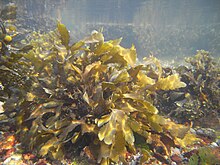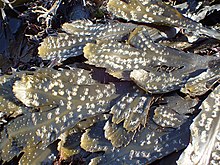Fucus serratus
| Fucus serratus | |
|---|---|
 | |
| Scientific classification | |
| Domain: | Eukaryota |
| Clade: | Diaphoretickes |
| Clade: | SAR |
| Clade: | Stramenopiles |
| Phylum: | Gyrista |
| Subphylum: | Ochrophytina |
| Class: | Phaeophyceae |
| Order: | Fucales |
| Family: | Fucaceae |
| Genus: | Fucus |
| Species: | F. serratus |
| Binomial name | |
| Fucus serratus L. | |



Fucus serratus is a seaweed of the north Atlantic Ocean, known as toothed wrack, serrated wrack,[1] or saw rack.[2][3]
Description and reproduction
Fucus serratus is a robust alga, olive-brown in colour and similar to Fucus vesiculosus and Fucus spiralis. The Fucus serratus is one of many plants that are multicellular. It grows from a discoid holdfast up to 180 centimetres (6 ft) long. The fronds are flat, about 2 cm (0.8 in) wide, bifurcating, and up to 1 m (3 ft 3 in) long including a short stipe. It branches irregularly and dichotomously. The flattened blade has a distinct midrib and is readily distinguished from related taxa by the serrated edge of the fronds. It does not have air vesicles, such as are found in F. vesiculosus, nor is it spirally twisted like F. spiralis. Male and female receptacles are on different plants.[4] The lamina shows cryptostomata – small cavities which produce colourless hairs.[5]
The reproductive bodies form in conceptacles sunken in receptacles towards the tips on the branches. In these conceptacles oogonia and antheridia are produced and after meiosis the oogonia and antheridia are released. Fertilisation follows and the zygote develops, settles and grows directly into the diploid sporophyte plant. The fertilization in the Fucus serratus would be associated with egg activation.
Distribution
Fucus serratus is found along the Atlantic coast of Europe from Svalbard to Portugal, in the Canary Islands.[6] It was introduced to the shores north-east America over 140 years ago, is presence described first at Pictou Harbour in the late 1860s by George Upham Hay and Alexander Howard McKay, it's introduction to Iceland and the Faroe Islands could date back to the Vikings, within the last 1000 years and was first noted in a phycological survey in 1900.[7][8]
Ecology
Fucus serratus grows very well on slow draining shores where it may occupy up to a third of the area of the entire seashore.[9] It often dominates the rocky parts of the lower shore, exposed or immersed in rock pools, on all but the most exposed shores.[10] "...the littoral zone is characterised especially by such Phaeophyta (brown algae) as Pelvetia, Ascophyllum, Egregia, Fucus and Laminaria, particularly when the shore is rocky".[11][12] It is considered an invasive species in the Canadian Maritimes, particularly on Prince Edward Island, Nova Scotia and the Northern coastline of New Brunswick. In Northern Europe and Iceland it is known to hybridize with Fucus distichus.[8]
Uses
Fucus serratus is used in Ireland and France for the production of cosmetics and for thalassotherapy. In the Western Isles of Scotland, it is harvested for use as a liquid fertiliser.[13] Since the organism contains triacylglycerols and fatty acids.
References
- ^ Alan P. Major (1977). The Book of Seaweed. Gordon Cremonesi. ISBN 978-0-86033-046-2.
- ^ David Chapman (2008). Exploring the Cornish Coast. Penzance: Alison Hodge. p. 26. ISBN 9780906720561.
- ^ "Serrated wrack". The Wildlife Trusts. Retrieved 15 March 2023.
- ^ L. Newton (1931). A Handbook of the British Seaweeds. London: British Museum.
- ^ C. I. Dickinson (1963). British Seaweeds. The Kew Series.
- ^ M. D. Guiry; Wendy Guiry (2006). "Fucus serratus Linnaeus". AlgaeBase.
- ^ W. R. Taylor (1972). Marine Algae of the Northeastern Coast of North America. University of Michigan Press. ISBN 978-0-472-08840-9.
- ^ a b Johnson, Ladd E.; Brawley, Susan H.; Adey, Walter H. (January 2012). "Secondary spread of invasive species: historic patterns and underlying mechanisms of the continuing invasion of the European rockweed Fucus serratus in eastern North America". Biological Invasions. 14 (1): 79–97. Bibcode:2012BiInv..14...79J. doi:10.1007/s10530-011-9976-z. ISSN 1387-3547.
- ^ J. A. Coyer; G. Hoarau; M. Skage; W. T. Stam; J. L. Olsen (2006). "Origin of Fucus serratus (Hereokontophyta; Fucaceae) populations in Iceland and the Faroes: a microsatellite-based assessment". European Journal of Phycology. 41 (2): 235–246. Bibcode:2006EJPhy..41..235C. doi:10.1080/09670260600652820. S2CID 86489103.
- ^ F. G. Hardy; M. D. Guiry (2006). A Check-list and Atlas of the Seaweeds of Britain and Ireland (PDF). British Phycological Society, London. ISBN 978-0-9527115-1-3. Archived from the original (PDF) on 2011-07-25. Retrieved 2007-06-27.
- ^ G. W. Prescott (1969). The Algae: a Review. Thomas Nelson & Sons. p. 301.
- ^ J. R. Lewis (1964). The Ecology of Rocky Shores. English Universities Press.
- ^ Gavin Earons. "Littoral Seaweed Resource Management". The Minch Project. Comhairle nan Eilean Siar. Retrieved December 19, 2009.











